You can cook a tasty, beautiful and healthy dish without bothering at all with all sorts of tricks, while spending a minimum of time.
I bring to the attention of blog visitors a recipe that is very simple to prepare, but very tasty, beautiful and healthy dish- basma, or stewed in own juice meat with vegetables.
The main idea embodied in this dish is to put into the cold cauldron meat and coarsely chopped vegetables, put on the very top cabbage leaves, for tightness, press it all with a small load and put it on slow fire simmer everything for 1.5-2 hours. The following recipe talks about a fire, one dish can be cooked perfectly on the stove.
To prepare this dish, you first of all need a cast-iron cauldron and:
- 1.5-2 kg of lamb (or beef). I recommend with a bone, it turns out very tasty.
- internal mutton fat, mesh, or beef fat
- 1 kg of onion
- 1-3 carrots
- 2-3 whole heads of garlic
- 1 small head of cabbage
- 3-5 pieces of tomatoes
- a bunch of greens (cilantro, dill, parsley, basil - to your taste)
- 1 hot pepper
- if available - eggplant
- salt, pepper, favorite seasonings (just one pinch)
So, we are preparing:
Original taken from medova_z_percem
in Basma.
One more Uzbek dish that conquered me - vegetable stew in own juice in a cauldron on a fire. How delicious it is is indescribable. Personally, I will cook only this dish until the end of this season. 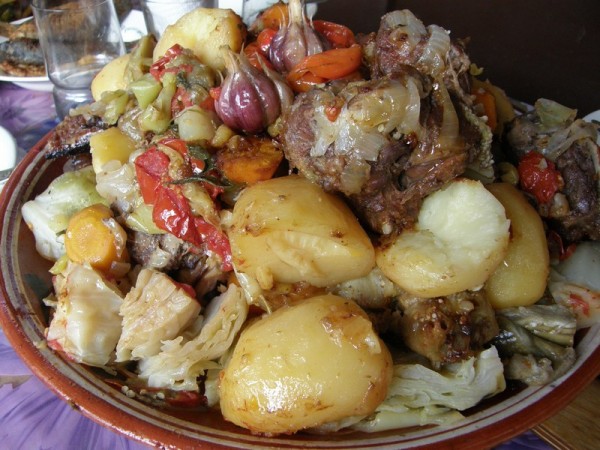
The bottom of the cauldron was lined with internal lamb fat, that is, with a mesh. Any available fat can be used. Meat big chunks. My lamb was bought in three days, so in order to preserve it, I marinated it in spices with salt and olive oil.

Pour the meat generously with onions in proportions of 1: 1. Salt the onion to release the juice.

Further, the order and choice of vegetables does not matter. What is available - all in a cauldron! I have potatoes, carrots, Bell pepper, zucchini, eggplant, tomatoes, cabbage, cilantro, celery, basil...
The main principle: vegetables must be cut coarsely, otherwise they will turn into vegetable caviar, which is also not bad) Whole potatoes, diagonally carrots.
In contact with
Push class
Earlier, when we lived in Uzbekistan, with the advent of the vegetable season, they always cooked very tasty dish Uzbek cuisine, with an interesting name damlama (dimlama). However, this dish was also called basma. I can not say with accuracy why the same dish was called differently. Although I was interested in this issue.
Someone said that the difference still exists. Allegedly, when preparing damlama, the meat is lightly fried, and when preparing basma, everything is cooked in its own juice, without preliminary frying. There was also another opinion that the name depended on the place where it was prepared.
Be that as it may, I always cooked this dish called damlama. That's what they call him in Samarkand, where I lived. So I propose to cook it today. Moreover, “damlama” literally means “steamed”. And we will cook it just for a couple.
Damlama is classic dish Uzbek cuisine. Same as , or . This is the favorite dish of the Uzbek people. It is cooked all season, as long as there are fresh vegetables. And now, when buying fresh vegetables is not a problem all year round, then prepare it as well.
As you can see from the name of the recipe, it is prepared from vegetables and meat. Moreover, absolutely any vegetables are used. Since this dish has been prepared since ancient times, it was first prepared from meat, onions, carrots and turnips. There were no potatoes, eggplants, peppers and tomatoes in those days in Uzbekistan. It was only then that they gradually began to be cultivated.
Gradually, new vegetables began to be added to damlama. And now this dish is very rich in vegetables. I like to cook it to the maximum, using all the vegetables available for the season. But this is by no means dogma. You can take the vegetables you want. Their number can also vary. From the set of products that is presented below, a full cauldron of 5-6 liters is prepared. That is, somewhere in the 6-7 full servings.
I have guests today, and therefore I am preparing a full cauldron. If you are cooking for a smaller number, then simply reduce the amount of ingredients.
There are many options for preparing damlama. Vegetables are always used in season. And you can always take different ones. So, in the autumn, potatoes are completely replaced by quince. Ordinary cabbage - cauliflower. Instead of apples, apricots or other fruits are used. And in winter, when the tomatoes are no longer so juicy, you can replace them with tomato paste. You can cook it with or without meat. And also use chicken and fish.
This dish is extremely easy to prepare. It is probably difficult to find another one that would be easier to cook than this. You also need to give him credit for the fact that despite the simplicity and ease of its preparation, it turns out to be very tasty and healthy.
- First, neither meat nor vegetables are fried.
- Secondly, a minimum of oil is used.
- Thirdly, everything is prepared practically for a couple.
- Fourthly, the dish is rather stewed than boiled. This means more vitamins and minerals are preserved.
- Fifthly, no liquid is added at all during the entire cooking. The dish is cooked in its own juice.
That is, you probably already wanted to cook damlama. And right! Especially. that the stores are just an abundance of vegetables. Just right for our meal. Today I went to the market and bought all the vegetables that I saw. Let's see what we will cook today, and what will come of it.
Uzbek damlama (basma) - vegetables stewed with meat in a cauldron, preparation
We will need:
- beef meat - 800 - 1000 gr
- onion - 3 pcs
- potatoes - 800 gr
- eggplant - 2 pcs
- zucchini - 2 pcs
- carrots - 2 pcs
- tomato - 2-3 pcs
- bell pepper— 2-4 pieces
- cabbage - 400 gr
- garlic -1 head
- apples - 2 pcs
- greens - parsley, dill, basil, mint, tarragon
- spices - zira, coriander, paprika
- red chilli pepper - 0.5 - 1 pc.
- salt, ground black pepper
- vegetable oil - 50 gr
- green onion - for sprinkling
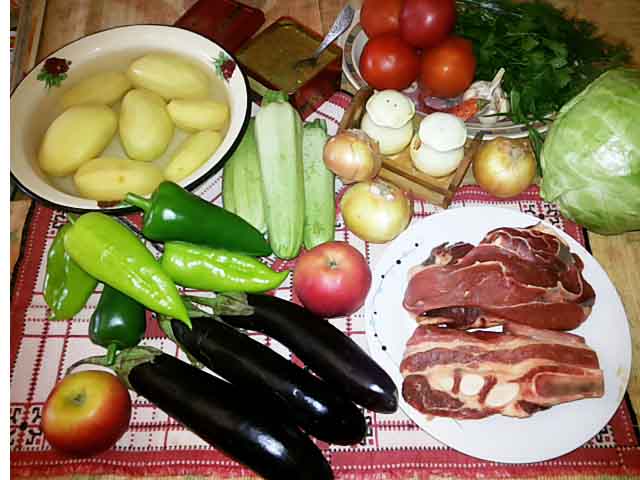
Training:
1. Meat for damlama can be either beef or lamb. Since we will cook practically without oil, it is good that the meat is a little fat. I use the brisket part, it is with bones and has the right fatty layers on it. And the tenderloin part, it's boneless and fat free.
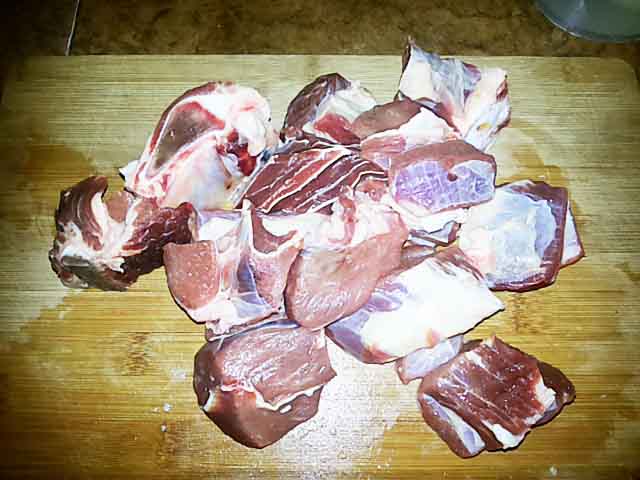
It happens that bacon is also used, which is laid as the first layer in a cauldron. It is believed that it protects the dish from burning. But I do not add bacon, I do not like the taste of it.
But if I cook from lamb, and I have fat tail fat, then I certainly put a small piece. A piece fat tail fat There is never any excess in such dishes. But today we cook from beef and without fat.
2. Wash the meat, let the water drain. And cut into medium pieces 6-7 cm thick.
3. Vegetables and herbs are also washed, cleaned and cooked so as not to forget anything.
4. Pour oil into the cauldron, about 1/4 of a glass. We try to get the oil on the entire surface of the wall, especially in its lower part. If you like fatter food, add a little more oil.
In general, the amount of oil depends on how fat you use the meat. It is clear that the fatter the meat, the less oil you need to add.
5. Spread the first layer of meat. If a piece with a bone, then it is better to lay it with the bone down.
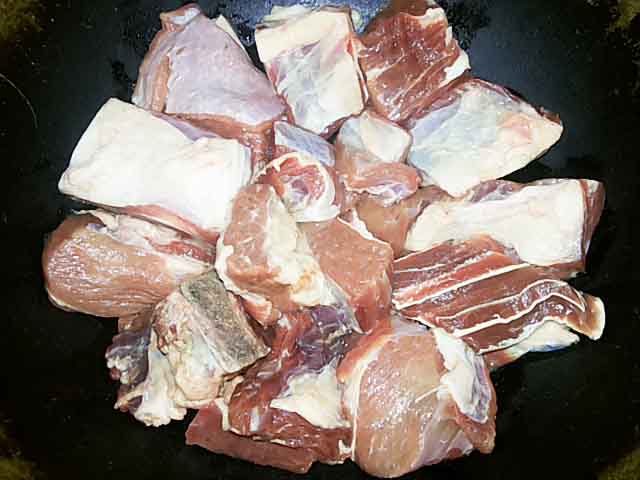
6. The next layer is carrots. We cut it into circles 2 cm thick, and if it is thin, then thicker cubes.
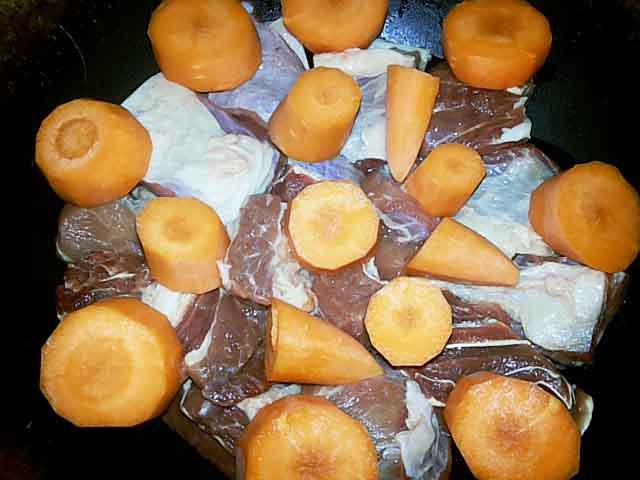
7. Then a layer of potatoes. We cut it larger so that it does not boil. We cut medium potatoes into two parts, and large ones into 3-4. Try to keep the size and shape the same.

Press the potato lightly with your hand. We do the same afterwards with each subsequent layer.
8. Place the peeled garlic in the center. When you cook a dish, be sure to try it. You will be surprised how unusual its taste has become.
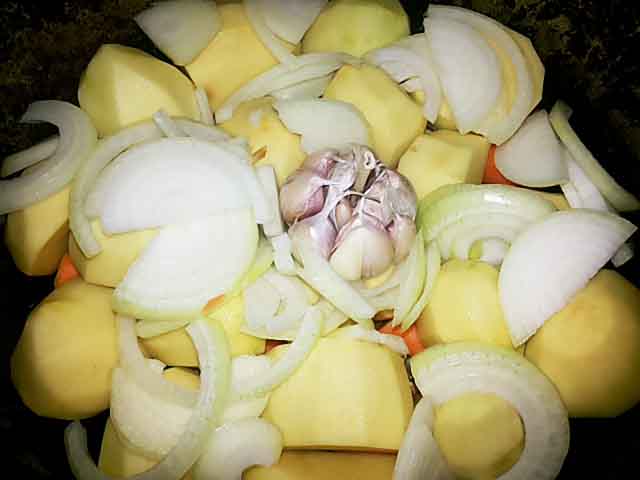
9. Cut the onion into half rings, 0.5 cm thick and lay out half.

10. Then bell pepper. We cut it into large feathers. Together with him we put red capsicum. My pepper is quite hot, and I put only half. If the pepper is not very hot, then you can add a whole pod.
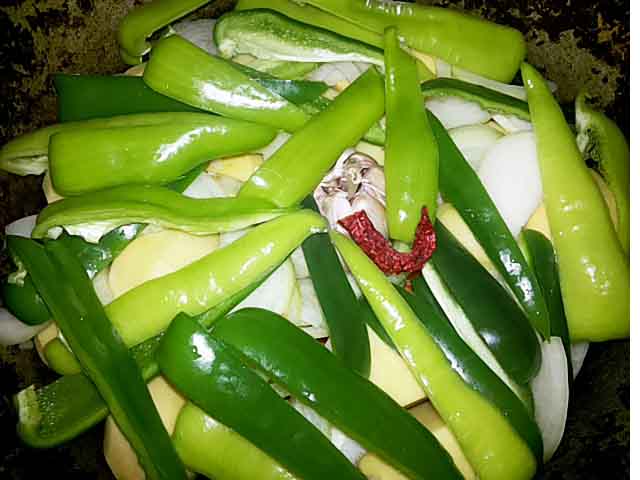
11. Then lay out the tomatoes. They can be cut into slices if the tomatoes are medium-sized. And maybe slices. Someone likes larger tomatoes, and puts small tomatoes whole, and cuts larger ones into two parts. The main thing is not to be too small. Some peel off the skin first, some don't. I leave it this time. The tomatoes were very thin skinned and very ripe. Therefore, there is no need to remove it.

12. Salt the layer with tomatoes. You can pour only half, and half later. The total amount of salt that I needed was 1 tbsp. spoon. Add spices and pepper. The strongest aroma immediately went from zira. I rubbed it lightly in my palms, and only then sprinkled it on the tomatoes.
13. Place two apples in the center. To give taste, it is better to add sour crumbly apples. Semerenko apples are good for this. But today I saw apples of a fresh harvest, and I took them. They are sweet and sour in taste.

14. Next - eggplant. We cut them into small rings 1.5 cm thick. Spread them in an even layer.
15. Then - zucchini, cut in the same way.
If you didn’t add salt in the middle, then add salt now.
16. Remove three whole leaves from cabbage. It's okay if they suddenly tear a little somewhere. Then cut the remaining cabbage into slices 2-3 cm thick. Spread it with the next layer.

17. Put greens and herbs on top.

18. And close everything with whole leaves of cabbage.
Preparation and serving of damlama (basma)

Eat while it's hot and enjoy the taste of young vegetables and juicy meat, washed down with a delicious fragrant broth.
Features of cooking damlama
- damlama (basma) is cooked on a very slow fire. This allows both meat and vegetables to be cooked from the inside. Thanks to this, the vegetables are tasty, moderately soft, the potatoes are crumbly, and the meat is juicy.
- the fact that we do not add water contributes to the fact that the vegetables are not boiled, but steamed. Steamed foods are undoubtedly healthier than boiled, and even more so fried.

- You can cook damlama not only with meat, but also with chicken and even with fish. Do everything exactly the same as in the recipe with meat.
- vegetable layers can be changed at will
- you can salt each layer, or in the middle and end
- layers need to be pressed lightly. This will allow the vegetables to warm up faster and release the juice.
- cut the vegetables to about the same size so they cook evenly.
- damlama is delicious and freshly prepared and will not lose its flavor the next day
- you can eat it both hot and cold
- a dish is prepared in a cauldron or thick-walled pan. Also now it is successfully cooked in a slow cooker. To do this is as simple as in a cauldron.
Recipe for making damlama in a slow cooker.
1. Wash the meat and cut into slices 6-7 cm thick.
2. Cut the vegetables into roughly equal pieces.
3. Put the meat into the multicooker bowl first, then the vegetables in layers. Layers can be done in the above sequence, or you can do it the way you want.
4. Set the "quenching" mode on the timer, and cook for 2 hours.
5. Post to big dish layers in reverse order.
It is very interesting to cook damlama (basma) in nature. With the smell of a fire, it turns out to be especially tasty and is eaten much faster than it is cooked! The main thing is to maintain the fire so that the fire is small. So that nothing burns and does not remain raw.
Cook damlama at home, in the country, and in nature! I'm sure. that having prepared once, you will want to cook it again and again. Damlama will fall in love with you, as it has been loved by the Uzbek people from ancient times to this day.
Bon Appetit!
In contact with
Housewives who have a slow cooker unanimously claim that it greatly simplifies the cooking process.
Food in the multicooker does not burn even with the minimum amount liquids, because during operation, the water cycle occurs inside: the steam rises when boiling, settles on the inside of the lid in the form of large drops, and those, in turn, again drain into the bowl.
In a slow cooker, you can cook absolutely everything. In it, even stew turns out to be especially tasty.
Let's take lamb, for example. Due to the specific smell, many housewives do not want to cook dinner from it. And you just need to choose the right meat, because only the meat of an adult, especially a male, has a smell. Young lamb turns out juicy and tasty even with a minimum amount of spices.
Distinguishing young meat from old is easy. Young meat is light red or pinkish in color, has white fat and almost no smell. If it is dark red, and the fat is yellow and comes from it bad smell, then you have an adult. And without preliminary soaking, pickling you can not do.
Lamb with vegetables in a slow cooker: the subtleties of cooking
In Asian, Caucasian cuisine and in some European ones, both first and second courses are prepared from lamb.
- But, given the presence of a peculiar aroma that comes from lamb during cooking, it is recommended to cook this meat with large quantity vegetables, herbs and spices. Moreover, they should have a pronounced aroma, but not so much as to drown out the natural smell of meat.
- Feel free to add onions, garlic, peppers, eggplants, potatoes, tomatoes, as well as beans, turnips, carrots, beans and greens to lamb.
- If you got lamb with a smell, cut it into pieces, sprinkle with vinegar, lemon juice or wine. After aging in the marinade, the smell will practically not be felt, and the meat will become softer. Try not to use vinegar if you intend to cook lamb with potatoes, as the acid will cause the potatoes to stay tough for a long time.
- In accordance with some recipes, the meat is first fried, and then vegetables are added in turn. Such dishes are hearty, with a rich taste and concentrated gravy.
- Other recipes call for meat and vegetables to be placed together. In this case, they are not mixed. During the cooking process, there is an abundant release of liquid from vegetables and meat, and they are stewed in their own juice. Such a dish turns out to be almost dietary and very tasty.
- Lamb with vegetables can become sweet and sour if stewed with tomatoes and paprika. If the meat is cooked with the addition of garlic, adjika, red pepper, then the dish will be with a spicy taste.
- When cooking lamb, do not fry it until brown. Such meat will eventually lose its juiciness and turn out to be less tasty.
- If the meat is not young, fry it, then pour in a little water and simmer until soft. And then put in the vegetables. Otherwise, they will be overcooked, and the meat will remain tough.
- Lamb with vegetables can be both the first course and the second. It all depends on how much liquid you pour into the bowl. Instead of water, you can take broth, beer, wine, tomato juice, liquid sour cream. And then, if you have the same composition of vegetables, you will always get dishes with a completely new taste.
Lamb stewed with vegetables in a slow cooker: the first recipe
Ingredients:
- lamb - 800 g;
- onions - 2 pcs.;
- carrots - 2 pcs.;
- tomatoes - 6 pcs.;
- Bulgarian red pepper - 2 pcs.;
- ghee - 30 g;
- salt;
- Bay leaf- 2 pcs.;
- peppercorns - 10 pcs.;
- sugar - 0.3 tsp;
- dry seasoning for meat - 0.5 tsp;
- garlic - 5 cloves.
Cooking method
- Cut lamb into portioned pieces. Sprinkle with seasoning and leave for one hour to marinate the meat a little.
- Turn on the multicooker in the "Frying" mode. Pour the oil into the bowl, melt, put the pieces of meat. Fry on all sides to form a crispy crust.
- Put the onion cut into wide half rings. Stir. Fry until the onion is soft.
- Grate the carrots Korean grater, put in a bowl. Stir again.
- Remove seeds from peppers, cut large pieces. Put in a bowl.
- After 2-3 minutes, add the diced tomatoes. When they give juice, pour in half a glass of water, put peppercorns, close the lid. Switch the slow cooker to the "Stew" program and cook the meat for 1 hour.
- Salt, put bay leaf, sugar and chopped garlic. Simmer another 15-20 minutes. Serve cooked lamb with vegetables mashed potatoes, buckwheat, crumbly rice or pasta.
Lamb stewed with vegetables in a slow cooker: recipe two
Ingredients:
- lamb - 800 g;
- onions - 3 pcs.;
- carrots - 1 pc.;
- eggplant - 1 pc.;
- Bulgarian pepper - 2 pcs.;
- hot red pepper - a small piece;
- tomatoes - 5 pcs.;
- vegetable oil - 2 tbsp. l.;
- salt;
- sugar - 0.3 tsp;
- ground coriander - 1 tsp
Cooking method
- Cut the prepared lamb into medium-sized pieces. Place in a bowl heated with one tablespoon of oil. Fry in the "Frying" mode until golden brown. Put in the chopped onion.
- When it is lightly fried, pour half a glass hot water, close the lid and, having set the “Stewing” program, cook the meat for 30 minutes. Salt.
- During this time, cut the carrots into circles, peeled peppers - into wide strips, hot peppers and chop the garlic.
- Slice the eggplant lengthwise and then slice across. Lightly salt and leave for 20 minutes. Drain the juice that stands out.
- Place carrots, eggplants, peppers in layers in a bowl. Lower the lid.
- Pour the remaining oil into the pan. When the pot is hot, put the sliced tomatoes, garlic, hot peppers, coriander, sugar and fry until the tomatoes have a uniform consistency.
- Cover the vegetables with this sauce. Simmer until meat and vegetables are soft. Serve with any side dish.
Lamb stewed with vegetables in a slow cooker: recipe three
Ingredients:
- lamb - 700 g;
- onions - 2 pcs.;
- carrots - 1 pc.;
- potatoes - 800 g;
- Bulgarian pepper - 1 pc.;
- garlic - 5 cloves;
- melted butter - 50 g;
- tomatoes - 3 pcs.;
- salt;
- black pepper;
- bay leaf - 3 pcs.;
- cumin - a pinch.
Cooking method
- Turn on the "Frying" mode. Cut the lamb into pieces, put in a bowl heated with oil. Fry until golden brown.
- Cut the onion and carrot into strips, add to the meat and fry everything together.
- Add diced potatoes, stir, cook 5 minutes.
- Chop the peeled pepper into strips, cut the tomatoes into cubes, chop the garlic. Put in a bowl. Salt, pepper, put bay leaf and cumin. Stir.
- Close the lid. Switch to the "Extinguishing" program and cook for 1 hour.
Note to the owner
If your multicooker does not have the "Frying" mode, replace it with the "Baking" mode.
Fry meat and vegetables with the lid open, close the lid when stewing.
The "Stew" program can be replaced by the "Soup" function, but you should be prepared for the fact that the dish will boil more actively.
GOOD AFTERNOON DEAR FRIENDS!
Stewed meat with vegetables in a cauldron Today I want to share the recipe
surprisingly simple, but so tasty and fragrant
dishes. It's summer now and it's time to cook such a dish.
In general, I really like stew with vegetables, we can say that this is one of the most
my favorite dishes, since I was born in Uzbekistan and lived there for a long time, and this is Uzbek
dish and call it "Domloma", which is cooked often. especially in the summer.
Cooking stew with vegetables can be as varied as
allows your imagination and your possibilities, that is, to cook from different varieties and
the vegetables you love the most.
Meat with vegetables in a cauldron obtained in its own juice, it is tender, fragrant, soaked
smells of vegetables, herbs and spices.
The most delicious stew is obtained from lamb with tail fat (tail fat is an accumulation of fat in
back of the ram).
So we are preparing "Domlama" - stew with fresh vegetables and spices in a cauldron.
WE WILL NEED:
- 1 kg lamb
- 250 - 300 g of lamb fat (fat tail),
- can be without fat (as an option beef with fat tail)
- 3 - 4 pieces of onions
- 2 carrots
- 3 pieces of bell pepper
- 2 small eggplants (preferably young, without seeds)
- 5 pcs tomato
- 5 - 6 pieces of potatoes
- 1 small fork of cabbage
- 4 - 5 garlic cloves
- herbs, salt
- seasoning: zra, ground allspice, bay leaf
COOKING stew with vegetables in a cauldron.
To begin with, we take a cauldron, because now we will put everything into it in layers.
We separate the meat from films and tendons, wash and cut into medium-sized pieces.
Onion clean, wash and cut into half rings.
We put 1/2 of the onion on the bottom of the cauldron, add a little salt and put the meat on top,
the remaining onion for meat.
Alternatively, the meat can be lightly fried, and then lay out the vegetables.
Salt, pepper, sprinkle with a little chopped garlic and sprinkle with spices
Carrots, clean, wash, cut into small cubes. Some to prepare it
dishes, cut everything into rings, I like cubes more, it's your choice.
We put the carrots on top of the onion and also add a little - a little and add
some spices. If you don't like a lot of spices, then don't.
We clean the bell pepper from grains and cut it again into small frames.
Put on carrots.
Then we have a turn of potatoes, also clean and cut, add salt and put on
Next you need to put the eggplant, cut into large cubes. I'm eggplant in advance
already cut, add salt and leave for 10 - 15 minutes,
so that bitterness comes out and then just squeeze them out and put them in a cauldron. 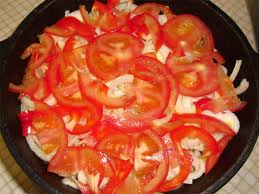
My tomatoes and cut the stalk, cut into two halves, and then each half
cut into half rings and carefully put in a cauldron, salt, pepper, add garlic and
seasonings and chopped herbs.
And the last thing we have left is cabbage. wash and carefully remove from the fork a few
whole leaves, trying not to damage, approximately 5 - 6 pieces, we will cover them
above our beauty. Cut a few leaves of cabbage into large cubes and put in
cauldron on tomatoes and add all that you have left of the spices: garlic, zru, herbs, salt
and pepper. Strongly do not get carried away, so as not to oversalt.
If you are cooking without fat tail and the meat is very lean, put a few pieces on top
butter(this is for an amateur).
And lastly, we take whole cabbage leaves and stack them as if we were making
cover. On top you need to put some kind of plate, a suitable size in diameter
cauldron. If you want more juice, then pour a cup, two waters and now
tightly close the lid of the cauldron, put on fire and let it boil.
When the meat begins to boil in a cauldron, the kitchen smells amazing, the smell of vegetables,
fresh herbs and spices. Then we make a small fire and let everything languish with us 40 - 50
minutes.
Serve hot and enjoy the taste of summer. 
And one more piece of advice do not overcook the meat with vegetables, this dish is good
freshly prepared. BON APPETIT EVERYONE!
I know that many do not like lamb and therefore I want to talk a little about this meat.
Man knowingly domesticated this animal about 10 thousand years ago. Our ancestors knew that
did. Here are some data: fat in lamb is two to three times less than in pork,
and cholesterol, which we are all so afraid of, lamb fat two and a half times less
than in beef and four times less than in pork.
Lamb contains substances that stimulate the pancreas and thereby
contributes to the prevention of diabetes, and also normalizes cholesterol metabolism. It's quite
a little about lamb, so that people who do not like it have an idea. 
WRITE WHETHER YOU LIKE THIS DISH, I WILL BE GRATEFUL TO YOU!
You may not believe it, but this meat literally melts in your mouth.
Delicious meat that anyone can cook!


in a cauldron or a regular saucepan fold lightly salted meat. Pour a little water - about a glass per kilogram of meat. Cover with a lid, put on medium heat, and when the fire starts to boil, turn down the fire, or even put it on the divider. Let the meat cook from an hour to an hour and thirty minutes - it all depends on the stiffness of the meat in its raw form.
I share a secret: if you understand that your meat is different, some pieces are tender, while others are more sinewy, tough, and even on the bones, then do as I did: lay the meat in a slide. Put the bones down and tough meat if there is fat on the meat, then fat to the bottom, and put softer pieces on top. Let the hard parts sit in the water and the soft parts steamed. In this case, a tagine lid works very well, although you can get by with a regular lid, on which you should lay a wet napkin.
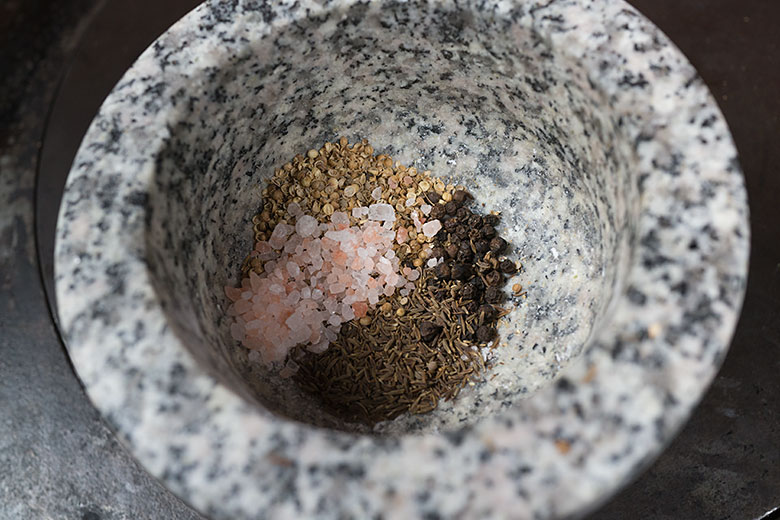
While there is nothing to do, grind spices and salt in a mortar, which should be chosen according to your taste.
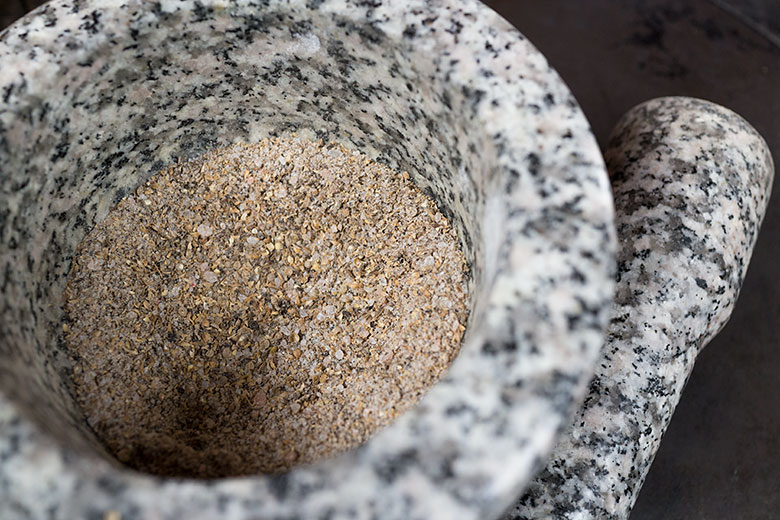
I share a secret: for lamb, I have not yet come up with anything better, how to mix coriander, cumin, salt and black pepper in a 2-1-2-1 ratio.

When the meat in the cauldron is ready, put a colander on the edge of the cauldron and put the meat in it - let the broth drain back. Add fire under the cauldron almost to the maximum and wait until the broth is almost evaporated. Then lower the meat in parts, sprinkle it with a mixture of spices and fry. The golden crust on the meat will appear very quickly, turn the meat with tongs so that it is fried on all sides and put it on the dish on which you will serve.
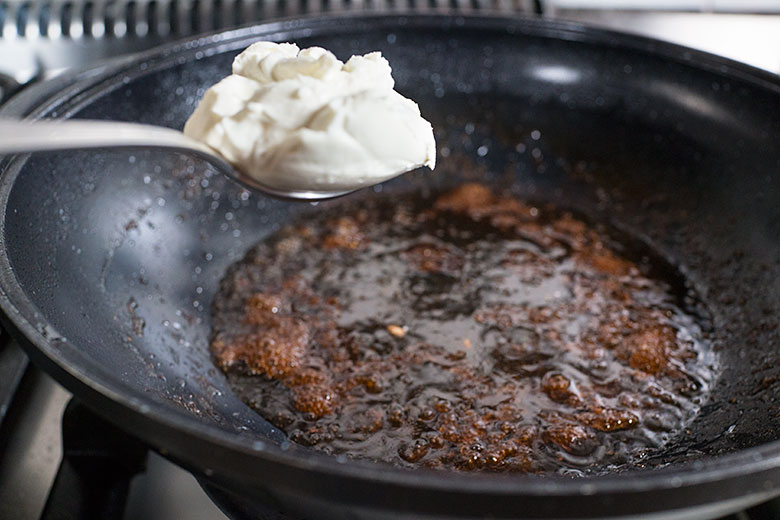
I share a secret: what is left in the cauldron after cooking meat is excellent workpiece for sauce. Add a glass to the pot good wine, scrape the bottom with a slotted spoon, let the squirrels stuck to the bottom dissolve. Taste and adjust for salt if necessary. Add a tablespoon of cream, if desired, or thicken the sauce in other ways. If the sauce is too greasy, then simply remove the oil from the surface with a spoon or a special tube, with a pear on the other end.

Such meat only looks fried, in fact it has a completely different texture. However, onions and sumac will go perfectly with such meat!
Meat with garlic and vegetables
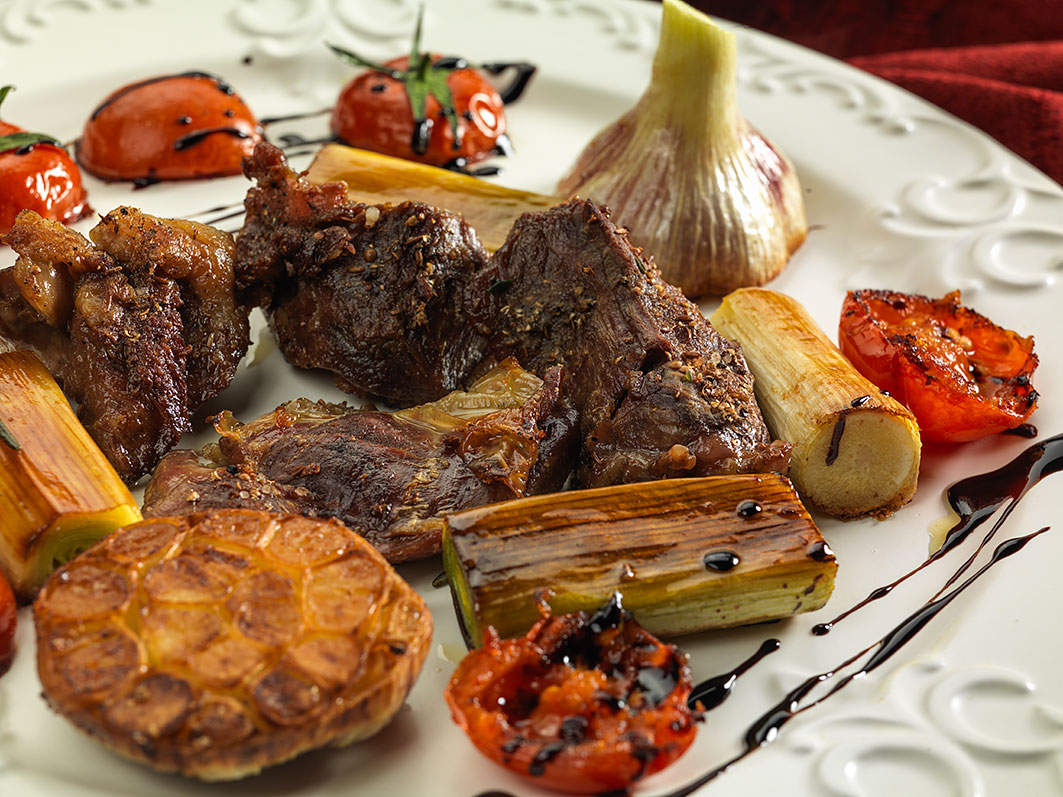

But there is another way to prepare such meat for serving. Pour into the pan olive oil and put the leeks on it. Fry it over low heat, setting yourself the task of not so much browning it as softening it.
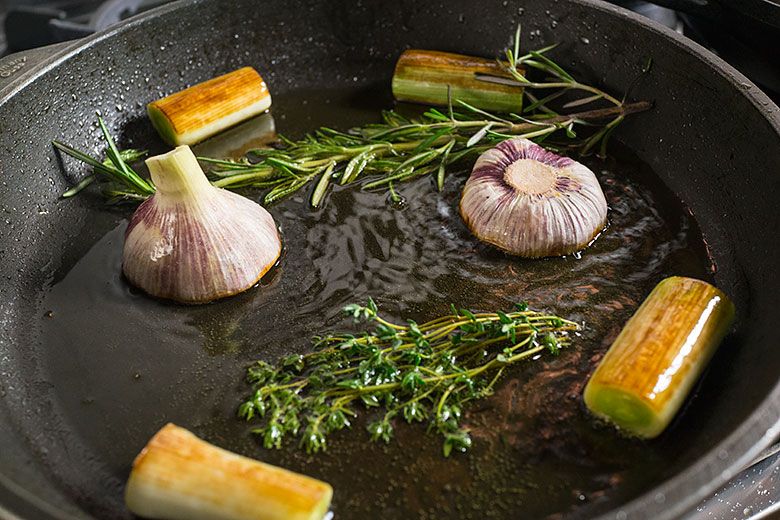
Add garlic, thyme and rosemary to the pan.
I share a secret: the bow could be ordinary, but large pieces, instead of thyme and rosemary, you could take bay leaves and capsicum whole, without opening it, if you do not want spicy.

Cut the tomatoes along the equator and spread them around the edge of the pan, where it's cooler. Put the pieces of prepared meat in the center and fry it, sprinkling with a mixture of spices and salt.
I share a secret: so much oil in the pan was necessary not because I love oil, but in order to ensure contact between the meat and the pan. Boiled meat is not as plastic as raw, and if there is not enough oil, then the meat will be immersed in oil only in places. After cooking vegetables and meat, this oil can be strained and used, for example, for frying potatoes - it only tastes better because the flavors of vegetables and meat remain in the oil. But this oil cannot be stored for a long time.
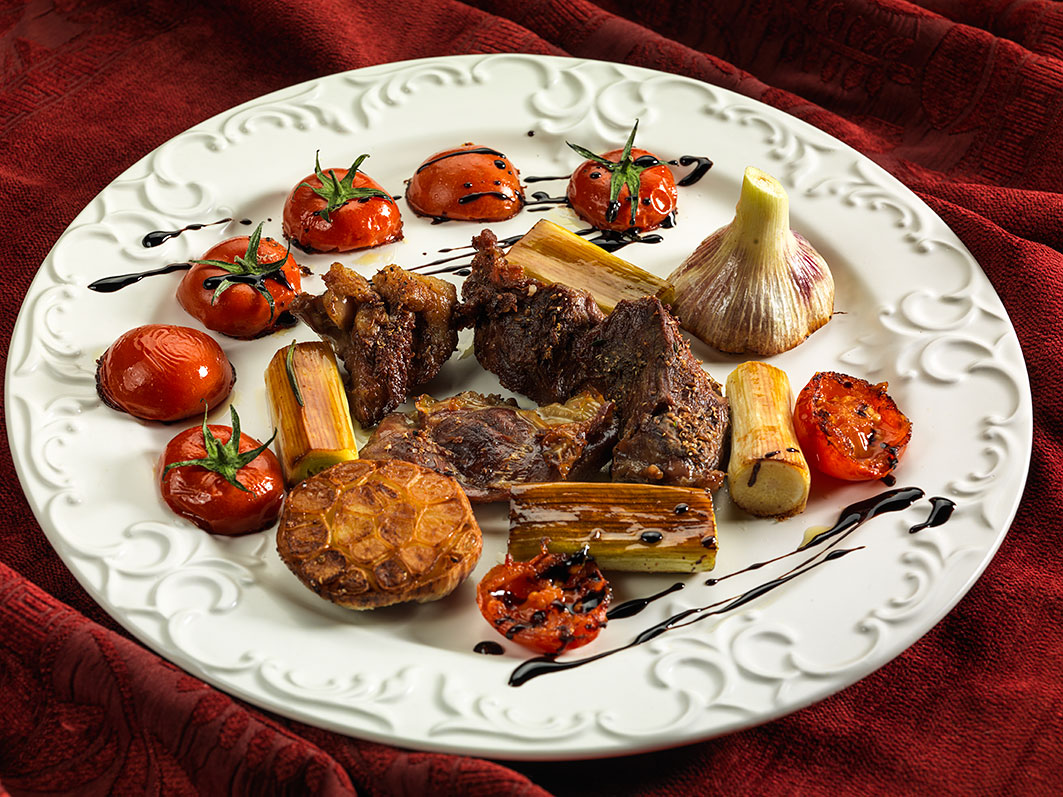
You can serve ready-made meat and vegetables without oil, and if desired, with balsamic vinegar.
Lamb with onions and mint sauce
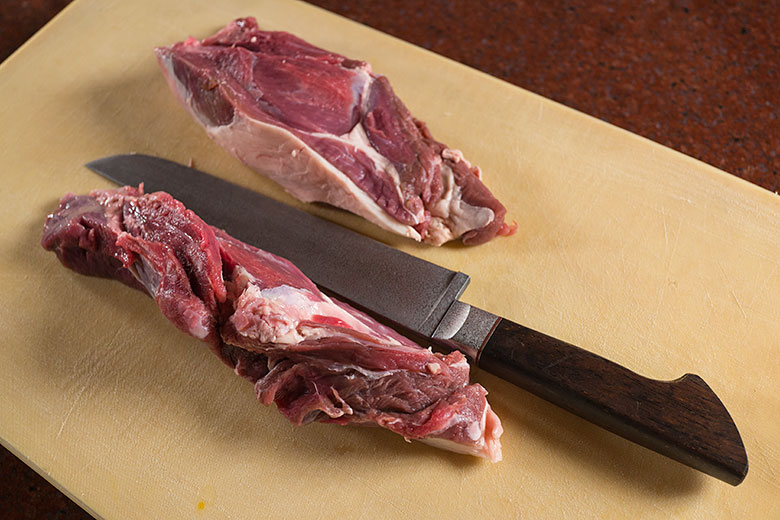
Almost any type of meat can be cooked this way, but if someone definitely wants to beat off the smell of lamb, then there is another way.

Salt and pepper the meat well. Wash and dry the mint and basil.

Cover the pieces of meat with leaves.
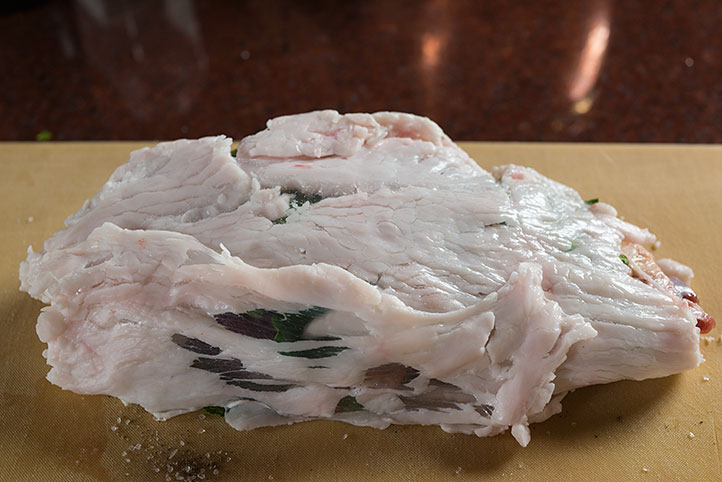
Wrap the meat with an omentum.
I share a secret: there is an omentum inside every animal, from a rabbit to a cow. Demand it from butchers - it's a wonderful product that can be used in dozens of different dishes.

Wrap the meat tightly with cling film, being careful not to leave air inside. Tie the ends into a knot.
I share a secret: it was possible to wrap the meat not with an omentum, but with frozen yogurt. In ordinary yogurt, put garlic, a lot of herbs, salt, pepper, beat with a blender. Pour into a flat dish and freeze.

Place the bundles in a special film and pump out the air with a vacuum pump, seal the edges.
I share a secret: just wrapping the meat with cling film is also quite enough. Even if during cooking a little water gets inside the package or a little broth comes out of the package, nothing bad will happen.

Place the meat in a thermostat bowl filled with hot water.
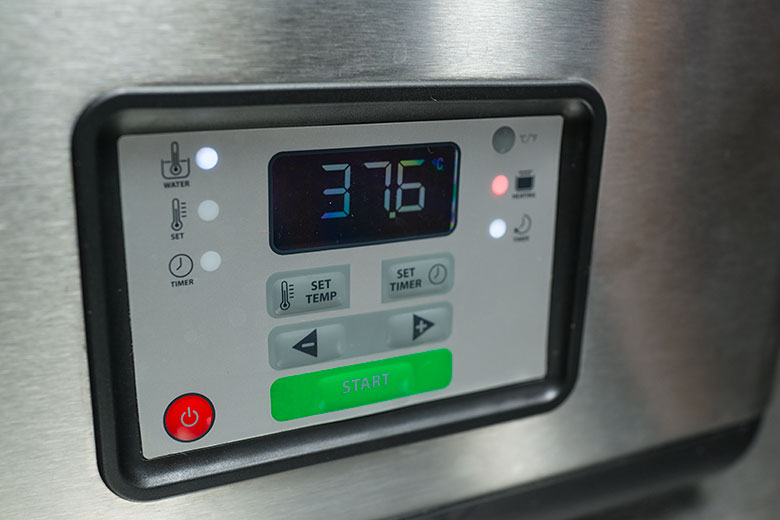
Set the cooking temperature for lamb to 72C, for beef 52-58C, for pork and poultry 85C. Choose the cooking time depending on the type of meat - from two to eight hours.
I share a secret: check with a thermometer what temperature your multicookers, slow cookers or rice cookers maintain in various modes. Chances are you can use one of these modes to cook meat this way. And if you don’t have a slow cooker, but have a head on your shoulders, then cook the meat in a steam or water bath, controlling the temperature of the water in the upper container with a thermometer. If you don't have a vacuum sealer or if you are delusional and don't want to use cling film in hot environments, then simply place the meat in one of the devices mentioned above, pour a glass of water and cook for several hours.

After cooking, place the bundles with meat in cold water with ice to cool them down as soon as possible.
I share a secret: after the meat has cooled, it can be put in the refrigerator and stored for several days, until you get hungry.
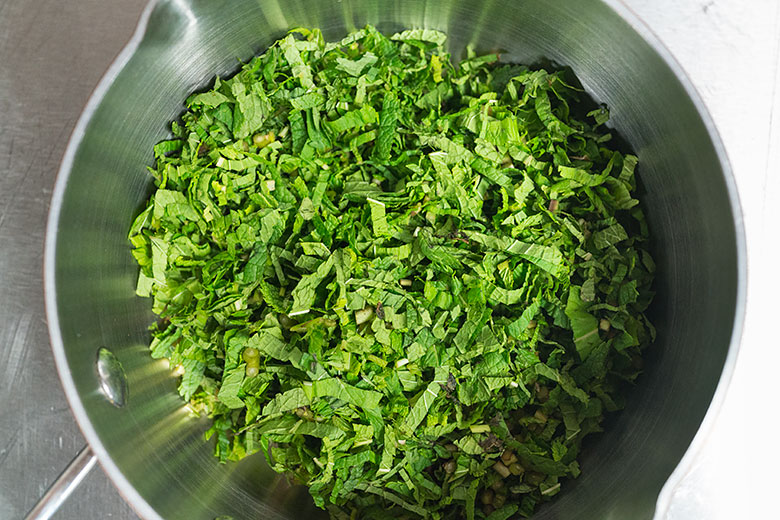
Chop the mint and put it in a saucepan.
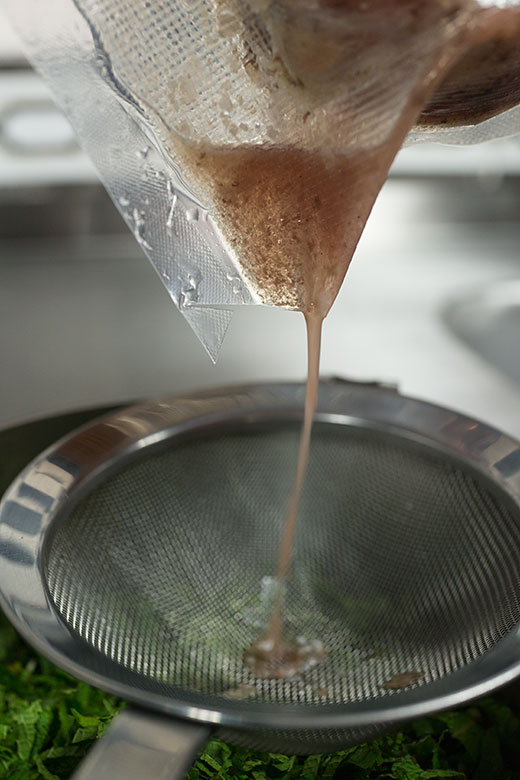
Snip the edge of the package and carefully strain the meat juice into the mint. If it's not enough, then add some water. The liquid should not cover the mint.

Bring the contents of the saucepan to a boil, but do not boil, but remove from heat and let cool. Strain the cooled mint infusion.
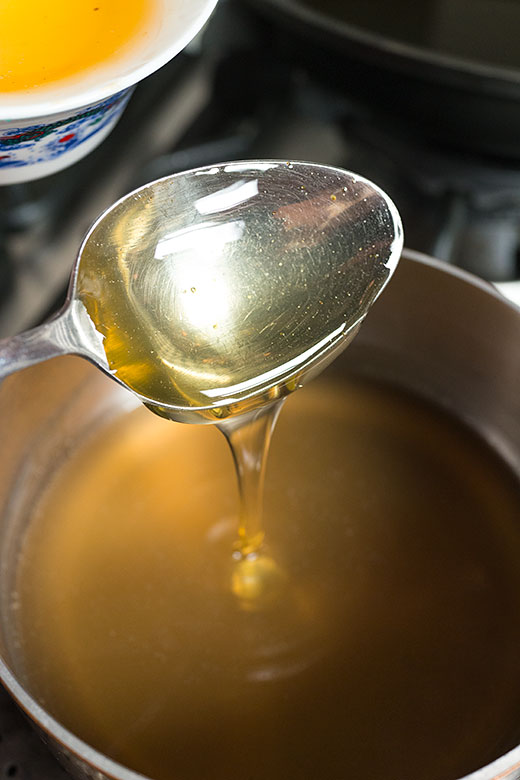
Add a spoonful of honey to the mint infusion.

Set to heat and add lemon juice taste. Salt if necessary.

Dilute a spoonful of starch in three tablespoons of water and let stand. Add starch to sauce and heat until thickened.

I share a secret: the sauce could be thickened in other ways.
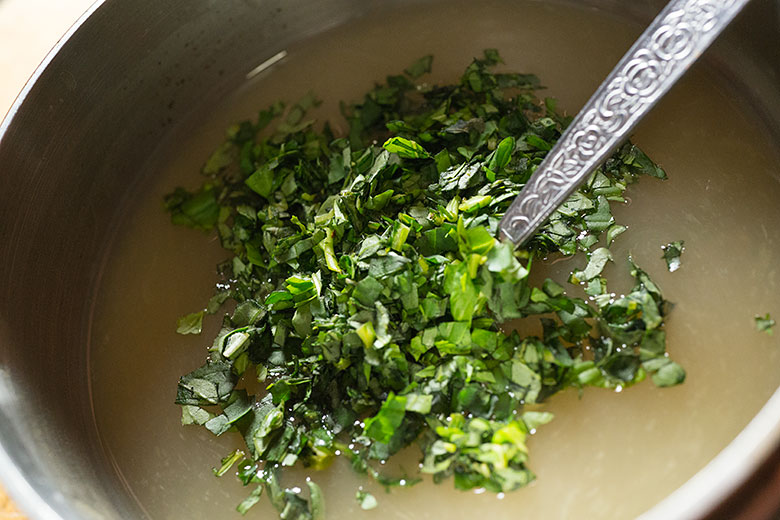
After the sauce has cooled to 50-60C, add chopped mint and basil to it, and, if desired, process it with a blender.
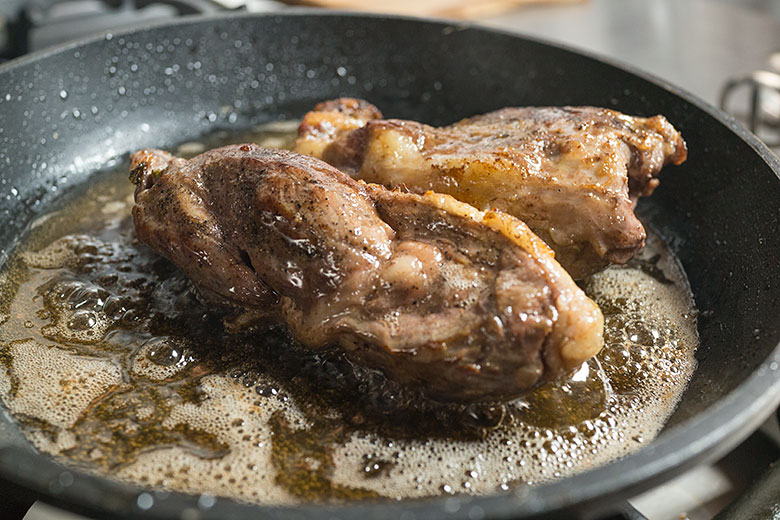
Open the package with meat, throw away all the frozen fat, omentum and greens. Fry the meat until golden brown in oil or animal fat.

Slightly fry the red sweet onions, drain all the oil from it.
I share a secret: the onion could not be fried, but scalded several times with boiling water.
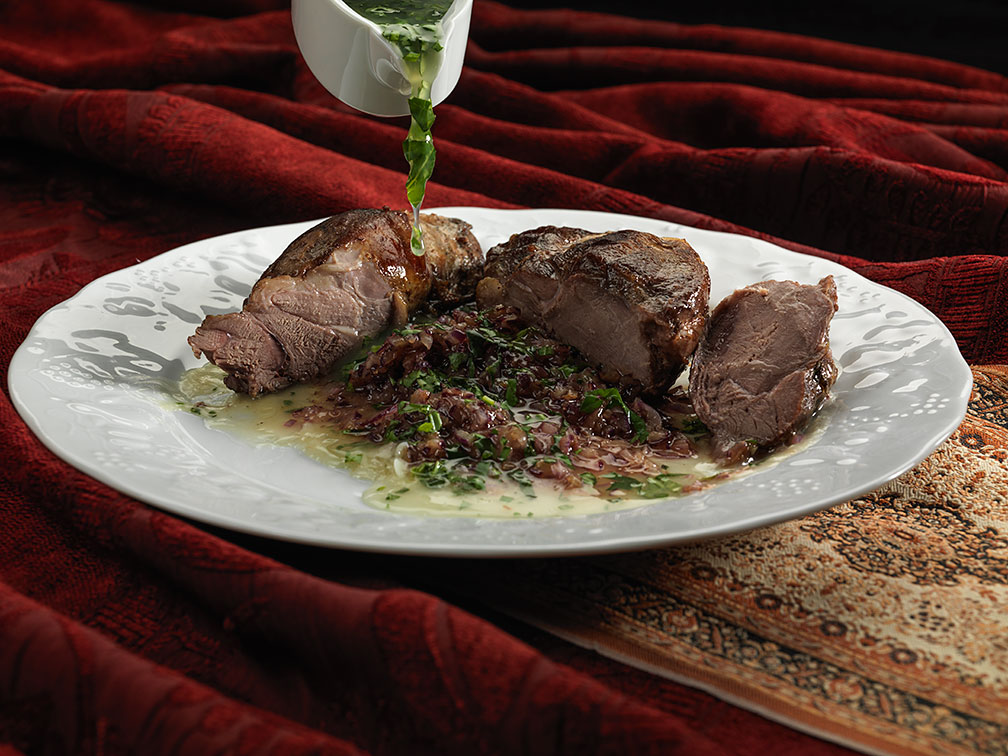
Serve meat with onions and sauce.

When you eat, try not to get dirty.
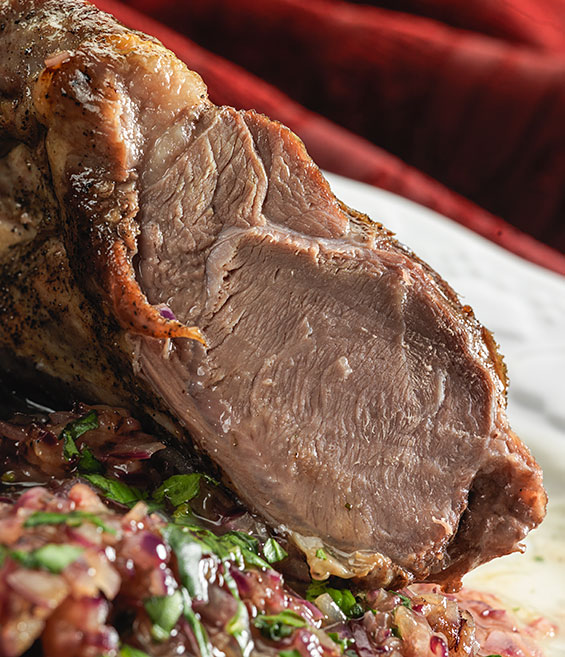
I share a secret: everything new is a well-forgotten old.
And don't forget: this is Sunday, Dorogomilovsky market, 15:00, the premiere of the sale of my new book MANGAL. Its content is as different from the previous ones as this article is from the well-forgotten old one (see the link in the previous paragraph).


